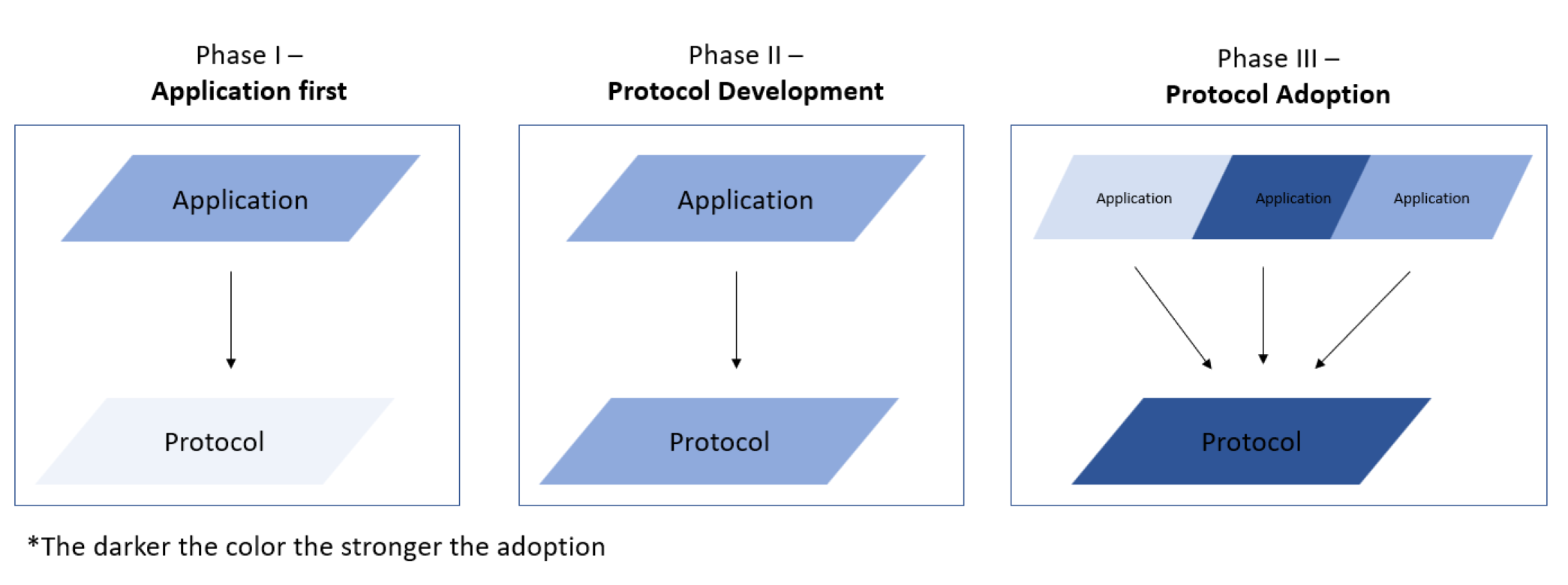app first, protocol later
TL;DR
- ‘app first, protocol later’ is a strategy to bootstrap crypto protocols
- The idea is to start from the application layer, gather user feedback, and than advance towards the development of the protocol
- This helps creating frequent product iterations, and prevents getting stuck on the protocol meaninglesss work that is not based on user data
“What we call the beginning is often the end. And to make an end is to make a beginning. The end is where we start from.” (T.S. Eliot)
bootstrapping crypto networks
One strategy that has gained significant traction in the web3 sphere is ‘app first, protocol later’.
This strategy revolves around initially focusing on developing a functional application or platform that makes use of an underlying protocol. The protocol itself is then enhanced and expanded later on.
What makes this approach effective is that it allows a project to garner feedback and data from the actual use of the application. This information can then be leveraged to refine the protocol, making it more robust and effective. Protocols are highly technical specifications, and it’s often challenging to boost their use without a working application (an exception to this is Ethereum, which started with the protocol, with applications following later).
I typically break this strategy down into three distinct stages:
-
Application First - At this stage, the primary focus is usually on bootstrapping usage through a user-friendly application. The data collected here acts as the driving force for repeated iterations on the protocol. The protocol at this stage might just be an early version (V1) that will eventually become more advanced.
-
Protocol Development - Once early usage of the application provides enough data to build and start iterating the protocol, the founding team shifts their focus from the application layer to the protocol’s development. At this point, the application has established some form of constant velocity, and the team can concentrate more on growing the protocol and attracting more applications.
-
Protocol Adoption - This stage is often referred to as the protocol’s valley of death and is considered the most challenging part. Here, individual teams begin to build unique applications on top of the protocol. These teams must trust that the protocol is solid and will continue to exist in the future, as they are essentially betting their own applications on its success. No one wants to build on shaky ground. When successful, the protocol expands into a constellation of applications built on top.
Adopting an ‘application first, protocol later’ approach offers several advantages:
-
It allows the project to gather real-world data and feedback from the application users, which can inform the development of the protocol and enhance its effectiveness.
-
It can help build a user base and establish a market for the application, laying a foundation for the protocol’s success once it’s launched.
-
It enables the project to showcase the potential value and utility of the protocol through the application, attracting developers, investors, and other stakeholders to the project.

Several crypto projects are currently leveraging this strategy:
Farcaster
This project is working towards a sufficiently decentralized social network. Farcaster’s idea is to build a protocol for a social network that anyone can use to build their own client. This means you can build your own social network clients, similar to Twitter, and tap into Farcaster’s existing network. You can build all sorts of clients, in a way that is optimized for different things. Think of Twitter with an open API on top that no one controls or can shut down.
Currently, Farcaster is in phase 1 of the process, bootstrapping a network that uses the Farcaster app.
Uniswap
The Uniswap protocol itself is a set of smart contracts on Ethereum and other blockchains, that enable anyone with a wallet to interact with the protocol permissionlessly. The interaction with the protocol might be done throughout the Uniswap ‘official’ app, but there are already many wallets and other applications that have been integrated into the protocol.
Uniswap started from a single app connected to a protocol, and now it is a constellation of applications, all connected to the protocol and creating a strong network effect of liquidity that is extremely hard to compete with.
Mirror.xyz
Mirror is a web3 publishing platform that aims to become a protocol for publishing. You can open an account using the web app (the login is wallet based), but once you publish your writings, it’s recorded into Arweave (decentralized storage) in a way that you can always control your publications and restore them through another app in a permissionless way.
The idea is that the creator controls his work, and can have full control even if the app changes the rules or gets shut down. There are all sorts of different cool features Mirror has embedded within the application (such as crowdfunding with NFTs), but it all eventually trickles down to the protocol layer which is the big oppurtunity.
Mirror is currently somewhere between phase 1 and 2 - there is usage and adoption for the application layer and more improvements are being met for the protocol layer.
conclusion
The ‘app first, protocol later’ playbook is a crucial step for successful crypto projects that want their protocol to become adopted. This strategy consists of three stages: application first, protocol development, and protocol adoption. By employing this method, projects can build strong network effects and pave the way for the protocol’s long-term adoption.